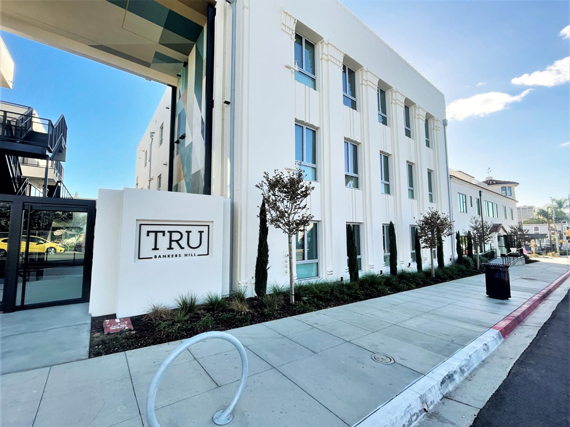|
Older Buildings = Climate Resilience
By Marlena Krcelich
March/April 2022
 The historic TRU Bankers Hill Apartments, at 2001 4th Avenue, San Diego, comprise three separate adaptively reused medical buildings constructed in 1924 in the Mission, Art Deco, and Brutalist styles. Completed in fall of 2021, the three-story project created 75 residential units and showcases an effective and attractive way to combat the region’s severe housing shortage. The developer preserved the exterior character and design of the original structures, while the new residential use meshes well with this trendy and evolving neighborhood. Courtesy Zillow.com |
The City of San Diego is missing the big picture by not including historic preservation alongside its other responses to climate change. Historic preservation and adaptive reuse of older buildings, rather than demolition, are proven tools for significantly reducing greenhouse gases, avoiding huge landfill dumps, and providing much-needed housing.
This is why SOHO supports policies that focus on reinvestment in older buildings, and regularly advocates for preservation to be included in all climate policies and discussions. We encourage you to urge your elected officials to prioritize historic preservation in all aspects of their work. Find their names and contact info HERE.
While new construction is frequently portrayed as more environmentally friendly than repurposing old buildings, the city and nation must also consider the high-energy costs of demolishing existing structures, discarding that waste into landfills, the production and transportation of new and raw building materials, and construction emissions that may last for years, depending on the scale of a project.
Existing buildings retain the embodied carbon from the energy and resources used to construct them. They also keep on giving: they can be retrofitted, updated, expanded, and reused in new ways.
Adaptive reuse of historic buildings with significance, character, and quality construction should be of large appeal to architects and developers. There are many designers who have already recognized the lucrative market for these novel living quarters and workspaces, and the public is enthusiastically embracing and seeking out these alternative places. The city also benefits socially, aesthetically, and financially from these historic preservation projects.
TRU Bankers Hill Apartments, described here with a photo, is a recent successful example of providing rental housing through creative adaptive reuse and inspiring architectural heritage.
The city’s progress in combating perhaps the biggest challenge of our times includes documents like the Climate Action Plan and Climate Resilient SD, discussed HERE.
What’s missing in these documents currently guiding San Diego is the retention, reinvestment in, and adaptive reuse of existing buildings.
To learn more about the connection between older buildings and climate resilience, check out these resources:
|
2025
2024
2023
2022
2021
2020
2019
2018
2017
2016
2015
|




